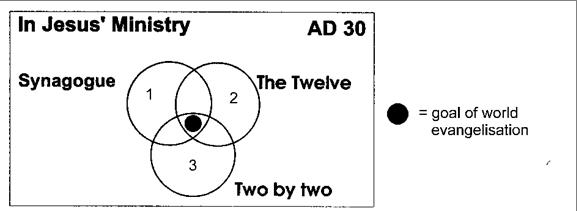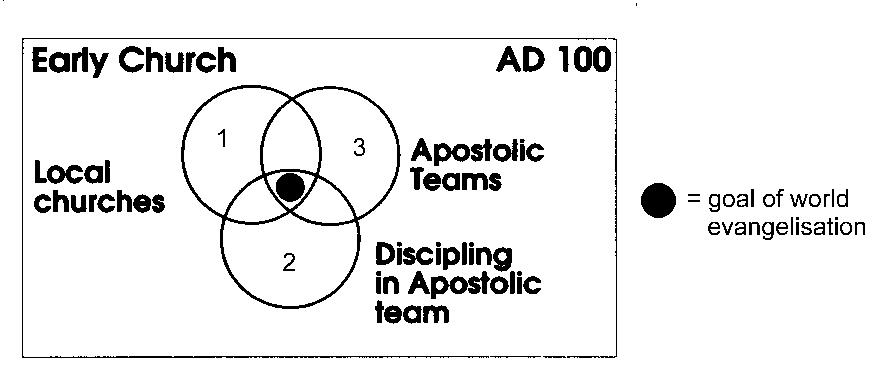Background Rationale
In a period of unprecedented cultural change, when the survival of many local churches is a real issue, there has been in recent times a swelling interest in practical Christian unity. This has not always been integrated with the place if mission in the life of the people of God. A helpful background for ongoing discussion of these matters is the ground breaking work The Church Is Bigger Than You Think (1998) by Patrick Johnstone. Johnstone puts forward the thesis that there are three essential operational structures forthe life of the church. These he nominates as:
- Ecclesial or gathering structures.
- Training structures.
- Sending structures.
According to Johnstone, these three structures were integrated in the ministry of Jesus and in the Early Church. What gave them coherence, and so effectiveness, was that they had a common goal: world evangelization. This he represents by the diagrams below.
- Ecclesial or gathering structures = synagogue.
- Training structures = Jesus teaching the 12.
- Sending structures = Jesus sending out the 12
- Ecclesial or gathering structures = local churches
- Training structures = discipling in apostolic teams (Paul to Timothy etc.)
- Sending structures = apostolic teams (Barnabas and Saul etc.)
He describes this as “three modes of operating for the one goal of world evangelism.” Obedience to the great commission was the platform for the expansion of early Christianity in a unified way.
Johnstone advances that these three modes have often been imperfectly integrated in the subsequent history of Christianity. This has severely inhibited the growth of the church.
With respect to contemporary Evangelicalism he arrives at the representation below which pictures how the contemporary spheres of the local church/denomination, theological institutions and para church/mission societies are often mutually uncoordinated and even competitive. This makes world evangelisation unlikely.
- Ecclesial or gathering structures = local churches/denominations.
- Training structures = theological institutions.
- Sending structures = mission societies and “ para church” organisations.
Johnstone’s thesis is that the reality for which we should aim looks like this:
Whilst the adequacy of Johnstone’s model may be questioned on a number of grounds, it provides the launching pad for fertile discussion. e.g.
- What would the mutual accountability of the different operational structures look like?
- How would this help mission?
- What sort of costs and challenges would be involved in reaching this level of cooperation?
- How could this sort of cooperation be achieved?
These are matters which we hope to explore in practical ways through our “Working Together Forum.”




